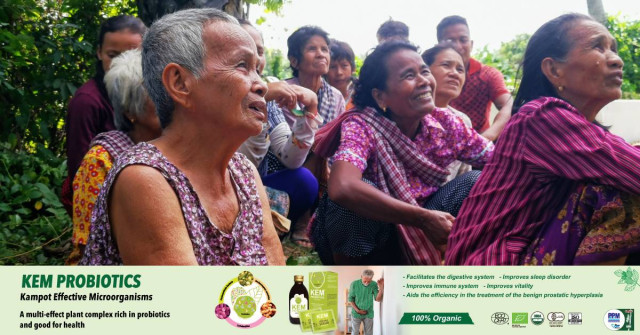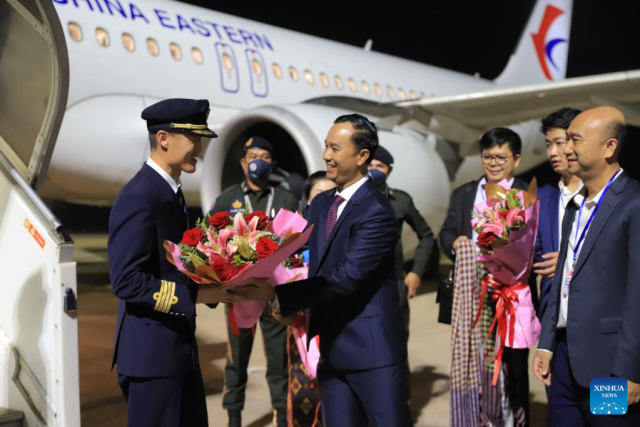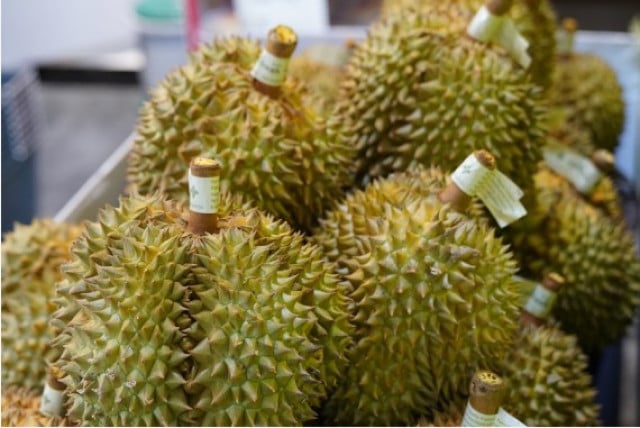Besides ECCC Trial, Khmer Rouge Survivors Need a Trusted Community

- By Teng Yalirozy
- January 9, 2024 7:10 PM
NEW YORK CITY – How can Khmer Rouge survivors and people left with deep trauma be healed in this fast-evolving and digitally-driven society? Building a trusting and close-knit community where empathy is shared could be the way, says Eve Zucker, an anthropologist whose research focuses on the aftermath of mass violence in Cambodia.
The researcher first visited Cambodia in the mid-90s as a tourist and was curious to learn about its recent history and the genocide during the 1970s. She became fascinated with the country and decided to study anthropology and to focus her research on the aftermath of mass violence in Cambodia through the lenses of social memory, morality, imagination, trust and everyday practices.
“[The first time I visited the country] I was struck that the signs of the civil war were very apparent. I was struck by how precarious that position was because the civil war was still ongoing, and the Khmer Rouge were still active,” she said during an interview with Cambodianess in December 2023 at the New York University.
“The juxtaposition of that was with the incredible resilience of the Cambodian people, and their kindness and efforts at looking forward and moving on, despite this tremendous trauma that they had endured.”
 Eve Zucker is an anthropologist whose research focuses on the aftermath of mass violence in Cambodia. Photo: Sem Vanna
Eve Zucker is an anthropologist whose research focuses on the aftermath of mass violence in Cambodia. Photo: Sem Vanna
Zucker started by volunteering at the Cambodian genocide program with Ben Kiernan at Yale University before pursuing her graduate studies.
“I pursue this question of what happens after such a traumatic episode, and after so much violence, and how do people pick up their lives again and carry on?” she said. “How do people and how does society recover from something like that? So that was the central question.”
She conducted her research in the Cardamom Mountains, in southwestern Cambodia, a location that served as a battlefield and base for the Khmer Rouge for almost thirty years.
Following the fall of Phnom Penh in April 1975, the Pol Pot regime emptied all the cities in the country and sent people to labor camps. Between 1975 and 1979, an estimated 2 million people died of forced labor, starvation, torture, or execution.
Educated middle-class people and intellectuals, such as physicians, attorneys, journalists, artists, and students were especially targeted. As the country was renamed Democratic Kampuchea, private property, money, religion, formal education and traditional culture were abolished.
Emotional Distress and Social Conditions
Zucker said that after the fall of the regime in 1979, the struggle faced by people was primarily due to the trauma of the past, the effects of violence, and poverty.
The loss of family members and the impact on future generations was significant, including managing the present, rebuilding after losing everything, and dealing with disease and sickness. Political and economic uncertainty further complicated the situation.
“The post-traumatic stress of what people endured and the incredible losses, which were experienced all through Cambodia and altered Cambodian society are certainly profound and have an impact, not only then but it's still present today,” she said.
 A Cambodian woman looks at portraits of victims of the Khmer Rouge displayed at the Tuol Sleng genocide museum in Phnom Penh on August 24, 2015. Photo: AFP
A Cambodian woman looks at portraits of victims of the Khmer Rouge displayed at the Tuol Sleng genocide museum in Phnom Penh on August 24, 2015. Photo: AFP
Trauma from war and genocide significantly impacts people's psychology, with post-conflict societies showing a higher prevalence of trauma-related mental health disorders.
Cambodia, for instance, has higher rates of post-traumatic stress disorder (PTSD) and major depression, highlighting the significant burden of societal mental illness on such societies compared to those that didn’t experience civil war or genocide.
According to “Trauma Psychology in the Wake of the Khmer Rouge: An Edited Volume on Cambodia’s Mental Health”, a book published by the Documentation Center of Cambodia (DC-Cam) in 2011, post-traumatic stress disorder (PTSD) affects 14.2 percent of first-generation survivors of the Khmer Rouge at that time, a ratio six times greater than the national rate in the United States.
A total of 11.5 percent of Cambodians were going through major depression while anxiety disorders affected 40 percent of the population at the time of publishing, the book added.
Similarly, a study in Long Beach, California, found a high incidence of PTSD among Cambodians (62 percent) who relocated to the United States after the end of the Khmer Rouge, highlighting the lasting negative psychological impact on these survivors.
But in 2024, while more than 60 percent of Cambodians were born after the fall of the Khmer Rouge regime, the question of trauma has been transferred to the new generations, who have heard the stories told by their loved ones and have been confronted with the social and economic consequences of the regime, but have not experienced it directly.
“Knowing this, it is important to determine whether the offspring of survivors of the Khmer Rouge show evidence of secondary traumatization – or indirect negative psychological effects of trauma – from growing up with parents who lived through the Khmer Rouge,” the book stated.
Coming out of the mass violence, the Cambodians rebuilt their lives from scratches. Having to deal with psychological trauma, they also had to wade through the uncertainty of the country while suffering from poverty, lack of daily necessities or diseases and inadequate healthcare.
Zucker said the limited resources, disease, sickness, political and economic uncertainty, and other issues make it challenging to rebuild and navigate.
Khmer Rouge tribunal is only a part of the healing
Established in 2006, the Extraordinary Chambers in the Courts of Cambodia (ECCC), also known as the Khmer Rouge Tribunal, announced its final verdict in September 2022, confirming the life sentence against Khieu Samphan, former Chairman of the State Presidium of the Democratic Kampuchea and known as ‘Brother number two’.
 Buddhist monks arrive at the court building to attend the verdict of former Khmer Rouge leaders Khieu and "Brother Number 2" Nuon Chea at the Extraordinary Chambers in the Courts of Cambodia (ECCC) in Phnom Penh on November 16, 2018. Photo by AFP / TANG CHHIN Sothy
Buddhist monks arrive at the court building to attend the verdict of former Khmer Rouge leaders Khieu and "Brother Number 2" Nuon Chea at the Extraordinary Chambers in the Courts of Cambodia (ECCC) in Phnom Penh on November 16, 2018. Photo by AFP / TANG CHHIN Sothy
The sixteen-year-long judicial process cost $337 million, with $45 million from Cambodia and the rest from 39 foreign countries – with Japan contributing the most – only for sentencing three former Khmer Rouge officials. Along with Khieu Samphan, Nuon Chea (1926 – 2019) and Keng Kek Iew (also known as Duch, 1942 – 2020) were also convicted to life imprisonment.
Christopher Ankersen, a Clinical Professor of Global Affairs at New York University, who was in Cambodia from 2010 to 2012 to engage in the Khmer Rouge courts, said the project was a necessary component to bring accountability to a horrible time in Cambodian history.
Ankersen, who at that time was responsible for the safety and security of the premises and the processes of the court, however, said it was detached and expensive, not bringing to light new information.
“It has never been able to bring to justice kind of other [people] outside [the inner circles of the Khmer Rouge regime] …It was a very small circle of three or four people. Duch and others were tried, but other members that perhaps had connections to current political parties were not brought to justice,” he said.
 Christopher Ankersen is a Clinical Professor of Global Affairs at New York University, who was in Cambodia from 2010 to 2012 to engage in the Khmer Rouge courts. Photo: Sem Vanna
Christopher Ankersen is a Clinical Professor of Global Affairs at New York University, who was in Cambodia from 2010 to 2012 to engage in the Khmer Rouge courts. Photo: Sem Vanna
He said that the Cambodian trial process has been a topic of debate among Cambodians, with some feeling satisfied with the outcome while others question the impact on their everyday lives.
Some Cambodians, as witnesses and victims, have had questions that cannot be answered satisfactorily, such as why the atrocities happened and why their families were singled out, Ankersen pointed out.
“I think in some senses, there was a real way in which this was a very tidy and expensive process that didn't deliver for everybody,” he said. “That is a lot of money to put three old men on trial who everybody knows already were responsible. There's not as if anything came out in the trial process that was new or unknown.”
Asked whether he thinks the process was a waste, he said there were several reasons why it would be a success, people got to see a fairly well-functioning process.
This was one of the first international tribunals that had brought victims in and allowed them to have a voice, and they had legal representation, which was very procedurally well done.
This procedural improvement raised expectations for compensation, but judges never had the authority to provide for it. Despite this, many victims felt well and had their voices recorded in transcripts, but no concrete restitution was provided, he said.
“I think there are many ways to look at the trials, depending on where you sit within Cambodian society. But not everybody would say this was an unalloyed success that it did very much for the country,” Ankersen said.
What else to do for survivors? A trusted community
Eve Zucker said collective and social memory shapes a society's identity while the narratives people talk about their past shape and their current state.
In Cambodia, the Khmer Rouge period is a significant part of the past. However, there is a larger history before the Khmer Rouge, including the Sihanouk period, the colonial period, and the aftermath of the Khmer Rouge.
As her research focuses more on local practice rather than the prosecution process of a few Khmer Rouge officials, Zucker said empathy, resilience, and imagination in recovery and coexistence play a role in rebuilding the community where everyone helps each other heal.
“People have one of the basic things that to overcome such a huge rupture as the Khmer Rouge is there has to be some kind of restoration of trust,” she said. “Everybody’s got to be willing to work together again, to support each other, to trust and have enough faith that there will be a future to work towards.”
The United Nations Development Program (UNDP) in Cambodia stated that trust, belonging, inclusion and security are the dimensions of social cohesion in Cambodia.
 Cambodian survivor of the infamous Tuol Sleng prison Bou Meng speaks to the media (C) after the verdict to uphold the genocide and life sentence of ex-Khmer Rouge head of state Khieu Samphan at the Extraordinary Chamber in the Courts of Cambodia (ECCC) in Phnom Penh on September 22, 2022. Photo: TANG CHHIN Sothy / AFP)
Cambodian survivor of the infamous Tuol Sleng prison Bou Meng speaks to the media (C) after the verdict to uphold the genocide and life sentence of ex-Khmer Rouge head of state Khieu Samphan at the Extraordinary Chamber in the Courts of Cambodia (ECCC) in Phnom Penh on September 22, 2022. Photo: TANG CHHIN Sothy / AFP)
Asked whether she went back to the community after her research, she said that she returned a couple of times and that some had recovered while some were still struggling to cope with the trauma and move on.
Zucker emphasized the importance of nations not just living within their borders but also learning about and caring about other people and nations, leading to graduate students and academics traveling to Cambodia to learn and understand the situation and its tragic history.
This encourages a wider view of the world and connects people with other cultures, she said, highlighting the negative consequences of focusing solely on the U.S. and not learning about other cultures or histories, believing that sharing experiences and knowledge can lead to a more peaceful world.
“I think one of the difficulties with such a devastating event like the Khmer Rouge is that people lost everything,” she said. “To be able to believe that you can build something and that it's going to last and even if it's not immediate and that trust will be a part of it, eventually you’ll get a community that heals each other.”















